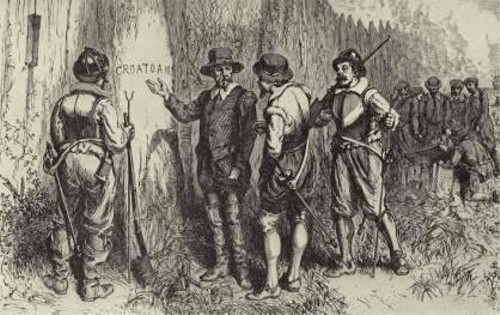Many countries including France, Spain, Britain, and Sweden, were looking to expand into the mostly unexplored continent across the Atlantic Ocean in the 1500’s. One of the first attempts was Roanoke Colony, on the island of Roanoke, by Sir Walter Raleigh.
Raleigh was an English aristocrat, writer, poet, soldier, courtier, spy, and explorer. His family was strongly Protestant and developed strong anti-Roman Catholic feelings when they were persecuted during the reign of the Catholic Queen Mary I. When Protestant Queen Elizabeth I began her reign and Sir Raleigh and his brothers were introduced in court, he became a favorite of the queen.

Portrait of Sir Walter Raleigh circa 1585
by Nicholas Hilliard
Public domain image.
Queen Elizabeth I granted Sir Raleigh a charter to explore. In 1585, he sent a few men to investigate the new world, who returned with a few Native Americans.
Based on their reports, Raleigh sent five ships the next time, led by his distant cousin Sir Richard Grenville. When all of the ships finally arrived at “Virginia” (named by Raleigh in honor of their virgin queen), they were low on supplies. Establishing relations with the resident Native Americans was difficult, to say the least. Several fights ensued.
Sir Grenville decided to leave Ralph Lane and 107 men to begin a colony on Roanoke Island while he sailed back to England for more supplies.
Sir Francis Drake, on his way back from a successful privateering trip in the Caribbean, stopped at the island and the colonists, tired of fighting with the Native Americans and extremely low on supplies, abandoned their fort and went home to England with him. Grenville arrived shortly after Drake’s departure, and, finding the fort abandoned, left several men there to maintain an English presence and departed for home again.
In 1587, Sir Raleigh sent another fleet of 115 colonists over to Roanoke Island, this time headed by John White, Raleigh’s friend. They were unable to find Grenville’s men. The native tribes were still hostile, and the colonists begged White to travel back and ask for help. He arrived home to find England at war with Spain. The Queen had ordered that no ships were to leave in case they were needed to fight the Spanish Armada.
After two years, White finally got passage on two privateering ships considered too small to be useful to the British fleet and sailed out, but the captains chose to try and overtake several Spanish vessels instead. They failed, and with no supplies left, the ships sailed back to England, having never made it to Roanoke Colony.
It took another three years, but White finally got passage on another privateering expedition that agreed to stop off at Roanoke Island. When they arrived, the colony was deserted. There was no sign of struggle or hurried departure. White and the colonists had previously agreed on a sign in case the colonists had to leave in distress; the sign was nowhere to be found.
The only note they left behind was the word “Croatoan” carved into a tree, and “Cro” carved into a gate post. White took this to believe that they had moved to the Croatoan islands nearby, but as a huge storm was brewing, he was unable to conduct a search and sailed back to England. No one knows what really happened, and they are now referred to as “The Lost Colony.”

John White discovers the word “CROATOAN” carved at Roanoke’s fort palisade.
Author Unknown | Public domain image
Sir Walter Raleigh did eventually try to find out what happened to Roanoke colony. He bought his own ship and crew and sailed over, but stopped in the outer banks to collect wood and plants to make a profit on back home. Before he ever made it to Roanoke, the weather turned bad, and he had to turn around and go home without ever seeing the island. Raleigh was accused of being involved in a plot to overthrow Queen Elizabeth’s successor, King James I, was found guilty of treason, and was imprisoned in the Tower of London for thirteen years. The king spared his life and he was released, but he was eventually executed in 1618.


